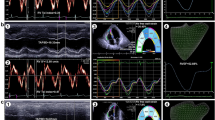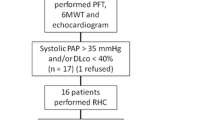Abstract
Purpose
Although computed tomography (CT) has been used previously to assess disease severity in lymphangioleiomyomatosis (LAM), the associations between the extent of pulmonary cysts on CT and six-minute walk test (6MWT), matrix metalloproteinases (MMPs) and vascular endothelial growth factor (VEGF-D) are not well established. We performed a cross-sectional study to quantify the extent of pulmonary cysts in CT and to establish their correlations with pulmonary function tests (PFTs), 6MWT results, including a composite index (desaturation–distance ratio, DDR), and levels of VEGF-D and MMPs in LAM.
Methods
Twenty-three LAM patients underwent CT scanning to automatically quantify the extent of pulmonary cysts and performed PFTs and 6MWT. Serum levels of MMP-2, MMP-9, and VEGF-D were also measured.
Results
The severity of pulmonary cystic involvement was mild (the extent of cysts was 6.8 %) and correlated best with FEV1/FVC (r = −0.84), residual volume (r = 0.66), DLCO (r = −0.82), the DDR index (r = 0.77), and desaturation during the 6MWT (r = −0.81). There was a weak correlation with VEGF-D (r = 0.45), but no association was found with MMP-2 and MMP-9.
Conclusions
The severity of pulmonary cystic involvement was mild in this sample of LAM patients and correlated best with airway obstruction, air trapping, reduced DLCO, the DDR index, and desaturation during the 6MWT. Serum VEGF-D cannot be completely defined as a valuable marker of disease severity and there may be a mechanism independent of MMPs to explain the formation of pulmonary cysts.



Similar content being viewed by others
References
Johnson SR, Cordier JF, Lazor R, Cottin V, Costabel U, Harari S, Reynaud-Gaubert M, Boehler A, Brauner M, Popper H, Bonetti F, Kingswood C, Review Panel of the ERS LAM Task Force (2010) European Respiratory Society guidelines for the diagnosis and management of lymphangioleiomyomatosis. Eur Respir J 35:14–26
Ryu JH, Moss J, Beck GJ, Lee JC, Brown KK, Chapman JT, Finlay GA, Olson EJ, Ruoss SJ, Maurer JR, Raffin TA, Peavy HH, McCarthy K, Taveira-Dasilva A, McCormack FX, Avila NA, Decastro RM, Jacobs SS, Stylianou M, Fanburg BL, NHLBI LAM Registry Group (2006) The NHLBI lymphangioleiomyomatosis registry: characteristics of 230 patients at enrollment. Am J Respir Crit Care Med 173:105–111
Baldi BG, Albuquerque AL, Pimenta SP, Salge JM, Kairalla RA, Carvalho CR (2012) Exercise performance and dynamic hyperinflation in lymphangioleiomyomatosis. Am J Respir Crit Care Med 186:341–348
Taveira-DaSilva AM, Hedin C, Stylianou MP, Travis WD, Matsui K, Ferrans VJ, Moss J (2001) Reversible airflow obstruction, proliferation of abnormal smooth muscle cells, and impairment of gas exchange as predictors of outcome in lymphangioleiomyomatosis. Am J Respir Crit Care Med 164:1072–1076
Yao J, Taveira-DaSilva AM, Colby TV, Moss J (2012) CT grading of lung disease in lymphangioleiomyomatosis. AJR Am J Roentgenol 199:787–793
Schmithorst VJ, Altes TA, Young LR, Franz DN, Bissler JJ, McCormack FX, Dardzinski BJ, Brody AS (2009) Automated algorithm for quantifying the extent of cystic change on volumetric chest CT: initial results in lymphangioleiomyomatosis. AJR Am J Roentgenol 192:1037–1044
Avila NA, Kelly JA, Dwyer AJ, Johnson DL, Jones EC, Moss J (2002) Lymphangioleiomyomatosis: correlation of qualitative and quantitative thin-section CT with pulmonary function tests and assessment of dependence on pleurodesis. Radiology 223:189–197
Avila NA, Chen CC, Chu SC, Wu M, Jones EC, Neumann RD, Moss J (2000) Pulmonary lymphangioleiomyomatosis: correlation of ventilation-perfusion scintigraphy, chest radiography, and CT with pulmonary function tests. Radiology 214:441–446
Paciocco G, Uslenghi E, Bianchi A, Mazzarella G, Roviaro GC, Vecchi G, Harari S (2004) Diffuse cystic lung diseases: correlation between radiologic and functional status. Chest 125:135–142
Crausman RS, Lynch DA, Mortenson RL, King TE Jr, Irvin CG, Hale VA, Newell JD Jr (1996) Quantitative CT predicts the severity of physiologic dysfunction in patients with lymphangioleiomyomatosis. Chest 109:131–137
Taveira-DaSilva AM, Pacheco-Rodriguez G, Moss J (2010) The natural history of lymphangioleiomyomatosis: markers of severity, rate of progression and prognosis. Lymphat Res Biol 8:9–19
McCormack FX, Inoue Y, Moss J, Singer LG, Strange C, Nakata K, Barker AF, Chapman JT, Brantly ML, Stocks JM, Brown KK, Lynch JP 3rd, Goldberg HJ, Young LR, Kinder BW, Downey GP, Sullivan EJ, Colby TV, McKay RT, Cohen MM, Korbee L, Taveira-DaSilva AM, Lee HS, Krischer JP, Trapnell BC, National Institutes of Health Rare Lung Diseases Consortium, MILES Trial Group (2011) Efficacy and safety of sirolimus in lymphangioleiomyomatosis. N Engl J Med 364:1595–1606
Pimenta SP, Baldi BG, Kairalla RA, Carvalho CR (2013) Doxycycline use in patients with lymphangioleiomyomatosis: biomarkers and pulmonary function response. J Bras Pneumol 39:5–15
Matsui K, Beasley MB, Nelson WK, Barnes PM, Bechtle J, Falk R, Ferrans VJ, Moss J, Travis WD (2001) Prognostic significance of pulmonary lymphangioleiomyomatosis histologic score. Am J Surg Pathol 25:479–484
Taveira-DaSilva AM, Stylianou MP, Hedin CJ, Kristof AS, Avila NA, Rabel A, Travis WD, Moss J (2003) Maximal oxygen uptake and severity of disease in lymphangioleiomyomatosis. Am J Respir Crit Care Med 168:1427–1431
Pimenta SP, Rocha RB, Baldi BG, Kawassaki AM, Kairalla RA, Carvalho CR (2010) Desaturation–distance ratio: a new concept for a functional assessment of interstitial lung diseases. Clinics 65:841–846
Young LR, Vandyke R, Gulleman PM, Inoue Y, Brown KK, Schmidt LS, Linehan WM, Hajjar F, Kinder BW, Trapnell BC, Bissler JJ, Franz DN, McCormack FX (2010) Serum vascular endothelial growth factor-D prospectively distinguishes lymphangioleiomyomatosis from other diseases. Chest 138:674–681
Young L, Lee HS, Inoue Y, Moss J, Singer LG, Strange C, Nakata K, Barker AF, Chapman JT, Brantly ML, Stocks JM, Brown KK, Lynch JP 3rd, Goldberg HJ, Downey GP, Swigris JJ, Taveira-DaSilva AM, Krischer JP, Trapnell BC, McCormack FX, MILES Trial Group (2013) Serum VEGF-D a concentration as a biomarker of lymphangioleiomyomatosis severity and treatment response: a prospective analysis of the Multicenter International Lymphangioleiomyomatosis Efficacy of Sirolimus (MILES) trial. Lancet Respir Med 1:445–452
Xu KF, Zhang P, Tian X, Ma A, Li X, Zhou J, Zeng N, Gui YS, Guo Z, Feng R, Zhang W, Sun W, Cai B (2013) The role of vascular endothelial growth factor-D in diagnosis of lymphangioleiomyomatosis (LAM). Respir Med 107:263–268
Odajima N, Betsuyaku T, Nasuhara Y, Inoue H, Seyama K, Nishimura M (2009) Matrix metalloproteinases in blood from patients with LAM. Respir Med 103:124–129
Hayashi T, Fleming MV, Stetler-Stevenson WG, Liotta LA, Moss J, Ferrans VJ, Travis WD (1997) Immunohistochemical study of matrix metalloproteinases (MMPs) and their tissue inhibitors (TIMPs) in pulmonary lymphangioleiomyomatosis (LAM). Hum Pathol 28:1071–1078
Pimenta SP, Baldi BG, Acencio MM, Kairalla RA, Carvalho CR (2011) Doxycycline use in patients with lymphangioleiomyomatosis: safety and efficacy in metalloproteinase blockade. J Bras Pneumol 37:424–430
Miller MR, Hankinson J, Brusasco V, Burgos F, Casaburi R, Coates A, Crapo R, Enright P, van der Grinten CP, Gustafsson P, Jensen R, Johnson DC, MacIntyre N, McKay R, Navajas D, Pedersen OF, Pellegrino R, Viegi G, Wanger J, ATS/ERS Task Force (2005) Standardisation of spirometry. Eur Respir J 26:319–338
Wanger J, Clausen JL, Coates A, Pedersen OF, Brusasco V, Burgos F, Casaburi R, Crapo R, Enright P, van der Grinten CP, Gustafsson P, Hankinson J, Jensen R, Johnson D, Macintyre N, McKay R, Miller MR, Navajas D, Pellegrino R, Viegi G, ATS/ERS Task Force (2005) Standardisation of the measurement of lung volumes. Eur Respir J 26:511–522
Macintyre N, Crapo RO, Viegi G, Johnson DC, van der Grinten CP, Brusasco V, Burgos F, Casaburi R, Coates A, Enright P, Gustafsson P, Hankinson J, Jensen R, McKay R, Miller MR, Navajas D, Pedersen OF, Pellegrino R, Wanger J, ATS/ERS Task Force (2005) Standardisation of the single-breath determination of carbon monoxide uptake in the lung. Eur Respir J 26:720–735
Pereira CA, Sato T, Rodrigues SC (2007) New reference values for forced spirometry in white adults in Brazil. J Bras Pneumol 33:397–406
Neder JA, Andreoni S, Castelo-Filho A, Nery LE (1999) Reference values for lung function tests. I. Static volumes. Braz J Med Biol Res 32:703–717
Neder JA, Andreoni S, Peres C, Nery LE (1999) Reference values for lung function tests. III. Carbon monoxide diffusing capacity (transfer factor). Braz J Med Biol Res 32:729–737
Ats A (2002) ATS statement: guidelines for the six-minute walk test. Am J Respir Crit Care Med 166:111–117
Soares MR, Pereira CAC (2011) Six-minute walk test: reference values for healthy adults in Brazil. J Bras Pneumol 37:576–583
Tobino K, Hirai T, Johkoh T, Kurihara M, Fujimoto K, Tomiyama N, Mishima M, Takahashi K, Seyama K (2012) Differentiation between Birt–Hogg–Dubé syndrome and lymphangioleiomyomatosis: quantitative analysis of pulmonary cysts on computed tomography of the chest in 66 females. Eur J Radiol 81:1340–1346
Conflict of interest
Bruno Guedes Baldi, Mariana Sponholz Araujo, Carolina Salim Gonçalves Freitas, Gustavo Borges da Silva Teles, Ronaldo Adib Kairalla, Olívia Meira Dias, Daniel Antunes Silva Pereira, Suzana Pinheiro Pimenta, and Carlos Roberto Ribeiro Carvalho have no conflict of interest to declare.
Author information
Authors and Affiliations
Corresponding author
Electronic Supplementary Material
Below is the link to the electronic supplementary material.
Fig. 1OR
Scatter plots showing association between the extent of cysts and pulmonary function tests results. FEV 1 forced expiratory volume in the first second, FVC forced vital capacity, RV residual volume, TLC total lung capacity. Supplementary material 1 (JPEG 51 kb)
Fig. 2OR
Scatter plots showing association between the extent of cysts and six-minute walk test results. 6MWT six-minute walk test, DDR, desaturation–distance ratio, SpO 2 peripheral oxygen saturation. Supplementary material 2 (JPEG 54 kb)
Fig. 3OR
Scatter plots showing association between the extent of cysts and DLCO and serum markers. DL CO diffusion capacity of the lungs for carbon monoxide, MMP metalloproteinase, VEGF-D vascular endothelial growth factor. Supplementary material 3 (JPEG 55 kb)
Rights and permissions
About this article
Cite this article
Baldi, B.G., Araujo, M.S., Freitas, C.S.G. et al. Evaluation of the Extent of Pulmonary Cysts and Their Association with Functional Variables and Serum Markers in Lymphangioleiomyomatosis (LAM). Lung 192, 967–974 (2014). https://doi.org/10.1007/s00408-014-9641-2
Received:
Accepted:
Published:
Issue Date:
DOI: https://doi.org/10.1007/s00408-014-9641-2




